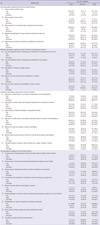1. Hussain-Gambles M, Atkin K, Leese B. South Asian participation in clinical trials: the views of lay people and health professionals. Health Policy. 2006; 77:149–165.
2. Rogers WA. Evidence based medicine and justice: a framework for looking at the impact of EBM upon vulnerable or disadvantaged groups. J Med Ethics. 2004; 30:141–145.
3. Lang T, Siribaddana S. Clinical trials have gone global: is this a good thing? PLoS Med. 2012; 9:e1001228.
4. George M, Selvarajan S, S SK, Dkhar SA, Chandrasekaran A. Globalization of clinical trials - where are we heading? Curr Clin Pharmacol. 2013; 8:115–123.
5. Casas JP, Cubillos-Garzón LA, Morillo CA. Regional pathologies and globalization of clinical trials: has the time for regional trials arrived? Circulation. 2003; 107:e194.
6. Glickman SW, McHutchison JG, Peterson ED, Cairns CB, Harrington RA, Califf RM, Schulman KA. Ethical and scientific implications of the globalization of clinical research. N Engl J Med. 2009; 360:816–823.
7. Thiers FA, Sinskey AJ, Berndt ER. Trends in the globalization of clinical trials. Nat Rev Drug Discov. 2008; 7:13–14.
8. Drain PK, Robine M, Holmes KK, Bassett IV. Trial watch: global migration of clinical trials. Nat Rev Drug Discov. 2014; 13:166–167.
11. Woolley M, Propst SM. Public attitudes and perceptions about health-related research. JAMA. 2005; 294:1380–1384.
12. Burt T, Dhillon S, Sharma P, Khan D, Mv D, Alam S, Jain S, Alapati B, Mittal S, Singh P. PARTAKE survey of public knowledge and perceptions of clinical research in India. PLoS One. 2013; 8:e68666.
13. van der Heyden MA, van de Ven T, Opthof T. Fraud and misconduct in science: the stem cell seduction: implications for the peer-review process. Neth Heart J. 2009; 17:25–29.
14. Hvistendahl M. Drug development. Corruption and research fraud send big chill through big pharma in China. Science. 2013; 341:445–446.
15. Kim JW, Kim SJ, Chung YH, Kwon JH, Lee HJ, Chung YJ, Kim YJ, Oh DY, Lee SH, Kim DW, et al. Cancer patients’ awareness of clinical trials, perceptions on the benefit and willingness to participate: Korean perspectives. Br J Cancer. 2008; 99:1593–1599.
16. Lee SJ, Park LC, Lee J, Kim S, Choi MK, Hong JY, Park S, Maeng CH, Chang W, Kim YS, et al. Unique perception of clinical trials by Korean cancer patients. BMC Cancer. 2012; 12:594.
17. Michaels M, Weiss ES, Guidry JA, Blakeney N, Swords L, Gibbs B, Yeun S, Rytkonen B, Goodman R, Jarama SL, et al. The promise of community-based advocacy and education efforts for increasing cancer clinical trials accrual. J Cancer Educ. 2012; 27:67–74.
18. Mackenzie IS, Wei L, Rutherford D, Findlay EA, Saywood W, Campbell MK, Macdonald TM. Promoting public awareness of randomised clinical trials using the media: the ‘Get Randomised’ campaign. Br J Clin Pharmacol. 2010; 69:128–135.
20. Korea Centers for Disease Control and Prevention. Attitudes and Perceptions of Clinical Trials in Public: Results from a Population-Based Survey [Unpublished Report]. Cheongwon: Korea Centers for Disease Control and Prevention;2009. p. 1–4.
21. Abbott D, Califf R, Morrison BW, Pierre C, Bolte J, Chakraborty S. Cycle time metrics for multisite clinical trials in the United States. Ther Innov Regul Sci. 2013; 47:152–160.
22. The Center for Information and Study on Clinical Research Participation (US). 2013 International Survey on Public and Patient Attitudes about, and Experiences with, Clinical Research Studies [Unpublished Report]. Boston, MA: The Center for Information and Study on Clinical Research Participation;2013.
23. Happer C, Philo G. The role of the media in the construction of public belief and social change. J Soc Polit Psych. 2013; 1:321–336.
24. Kim H. Exercise rehabilitation for smartphone addiction. J Exerc Rehabil. 2013; 9:500–505.









 PDF
PDF ePub
ePub Citation
Citation Print
Print






 XML Download
XML Download